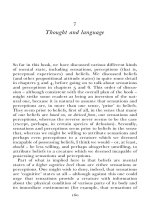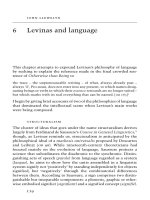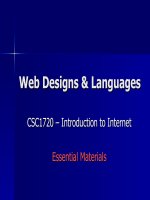Lecture Meaning and language Part 1
Bạn đang xem bản rút gọn của tài liệu. Xem và tải ngay bản đầy đủ của tài liệu tại đây (177.51 KB, 26 trang )
Meaning and Language
Part 1
Plan
• We will talk about two different types of meaning,
corresponding to two different types of objects:
– Lexical Semantics: Roughly, the meaning of individual words
– Compositional Semantics: How larger objects (clauses, sentences)
come to mean what they do. Relatedly, how formal logic can be used
as a tool to study language
• However: These two fit together, as discussed in the
reading (Partee)
•
That is, aspects of what we want to say about what words mean will interact with what we
say about larger structures
• Today:
– Some distinctions
– Basic sets and truth conditions
– Working towards logic for language
Some Initial Points
•
Remember that for (content) words like cat, tree, horse, etc.
there is an arbitrary connection between sound form and
meaning:
Sound and Meaning
• This pairing of sound and meaning is one
component of language
– “arbitrary” component: stressed by de Saussure
– “predictable” component: logic, etc.
• Rock bottom: basic connections in small units
(morphemes,words) between sound and meaning
• The full range of things that we associate with human
language is found only when such connections are
part of a generative system for creating larger units
from smaller ones, i.e. the syntax (remember last
week)
Outline
• Traditional distinctions for sound/meaning
connections (homophony, polysemy)
• Words and sets (as in set theory)
• Basic cases (nouns and adjectives)
• Wednesday: Using formal logic to model
meaning relations in language
Some Distinctions
• First: cases in which the “one to one”
mapping between sound forms and meanings
is not so direct.
– Homophony: A cases in which two words have the same
sound form, but distinct and unrelated meanings
• Bank-1 ‘side of a river’
• Bank-2 ‘financial institution’
Representation
• In any case, with homophony we are dealing
with distinct words; that is:
– Bank-1 is to Bank-2 as cat is to dog or bank-1is to
cat
• This is equivalent to saying that in such
cases, the identity in sound form is an
accident
• In other cases of the same sound form but
differing meaning, this is not the case
Polysemy
• We speak of polysemy ‘many meanings’ in
cases in which we have the same word but
with distinct yet related senses; one case:
– Pool: water on the ground
– Pool: swimming pool
• In this case, there is no need to say that there
are different words; perhaps really different
senses of the same word
Polysemy, cont.
• Sometimes with polysemy the intuition is that the word is basically
‘vague’, and that its fuller meanings are supplied by context
• Something similar is found with verbs, where the context comes
from the syntactic structure:
– The whistle sirened lunch time.
– The police car sirened the speeder to a stop.
• Cases like this indicate that the basic meaning of words can be
augmented with information from the syntactic structure
– John shinned the ball.
– Mary shinned the ball to John.
– Etc.
• The “core”meaning of the word shin or siren exists, but is
augmented by what happens in the syntactic structure
Words and Sets
• Let’s take an example of how we think of word
meanings…
• More interesting: how meanings of combinations
of words are derived
• We can think of the meaning of some words as
relating to a system of categories, some more
general, some more specific
• This lends itself to representation in terms of sets
• A set is, for our purposes, an abstract collection
Examples
• Consider the relationship between dog and
mammal:
– All dogs are mammals. (true)
mammals
dogs
dogs
Examples, cont.
• The set relationship is one of inclusion; the
set denoted by dog is a subset of the set
denoted by mammal
• Other relationships are possible as well, both
in terms of ‘some’ and ‘no’
• We will formalize an extension to this in the
next lecture
‘Some’ and overlapping
• It is not true that all snakes are poisonous:
– All snakes are poisonous. (false)
• But some are:
– Some snakes are poisonous. (true)
• In cases like this, the set denoted by snake and the
set denoted by poisonous overlap:
snakes
Poisonous
things
Non-overlapping: ‘No’
• It can also be the case that sets do not
overlap, in addition to overlapping in very
small ways
• Consider the following:
– No mammals are poisonous.
• Ok, we want to know what no means, but is
this a good example (is it true)?
As far as I know…
•
As far as I know, the statement ‘No mammals are poisonous’ is
false
• The duck-billed platypus has a kind of poisonous thing on its leg
Sets
• So we need another example of sets that
don’t overlap
– No dogs are reptiles. (true)
dogs
reptiles
Truth Conditions
• One way of approaching meanings is to look
at the truth conditions of sentences
• The truth conditions specify in precise terms
the circumstances that obtain in order for a
sentence to be true (or false)
• Specifying the truth conditions is a necessary
component of the study of meaning; if we can
show that two sentences are true under
different conditions, then we would like to say
that they have different meanings
Some examples
• Sometimes it seems like the specification of
truth conditions is trivial:
– The cat is on the mat.
– The dog is on the mat.
– Different truth conditions
• But what about more complex cases?
Consider:
– The glass is half full.
– The glass is half empty.
The ‘Glass’ Example
• On the face of it, ‘half full’ and ‘half empty’ seem
to have the same truth conditions.
• But: Consider the following examples:
– The glass is almost half full. (e.g. 48%)
– The glass is almost half empty. (e.g. 53%)
• These have different truth conditions
– Assuming that ‘almost’ is the same in the two
sentences, it must be the case that ‘half full’ and ‘half
empty’ actually have different meanings
– If these two phrases were not different in meaning,
where else could the difference come from??
Other fractions
• As a further point, consider what happens
when we replace ‘half’ by other fractions:
– The glass is three eighths full.
– The glass is three eighths empty.
• These do not mean the same thing
• It looks as if ‘half full’ and ‘half empty’ mean
different things, but sometimes can be true
under the same circumstances
More on Adjectives
• Some further cases from the study of
adjectives illustrate
– The relevance of our use of sets above
– The interaction of lexical meaning with compositional
meaning
• Let’s take another simple example:
– poisonous snake
Interpreting poisonous snake
• One way of thinking of the adjective meaning
with respect to the noun follows on what we
were doing above
• What we would like are some general rules
that tell us how to interpret certain syntactic
objects in terms of the semantics we are
using
• Rule (informal): When an adjective A
modifies a noun N ([A N]), the interpretation of
this object is the set defined by the
intersection of A’s meaning with N’s meaning
On the interpretation, cont.
• This is just like the rule we saw above:
snakes
Poisonous
things
•With poisonous snake, we are indicating a member
of the overlap between two sets
•This can be indicated in a logical notation as well
Some notation
• We need a notation for sets and their
interaction
– || X || = the set of things denoted by property X
• Example: || red || = the set of red things
• This can also be written as {x| x is red}, read as ‘the set
of all things x such that x is red’
– What about how adjectives and nouns combine by
the reasoning above?
• We need notation for ‘and’; why? Because the things that
are poisonous snakes are the set of things that are (1)
poisonous AND (2) snakes
Putting the pieces together
• So, for poisonous snake:
– || poisonous || = {x|x is poisonous}
– || snake || = {x|x is a snake}
– || poisonous snake || = {x| x is poisonous AND x is a snake}
• We can also use set notation for this, e.g.:
– || poisonous || ∩ || snake ||









